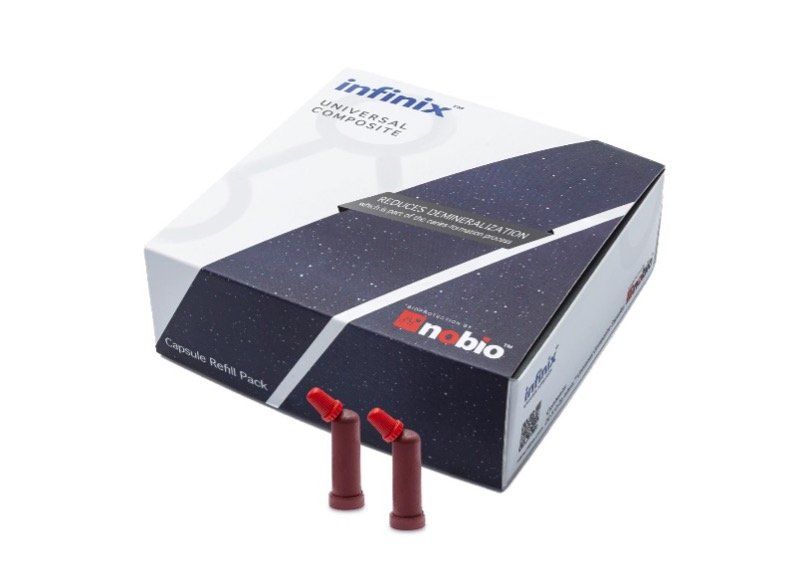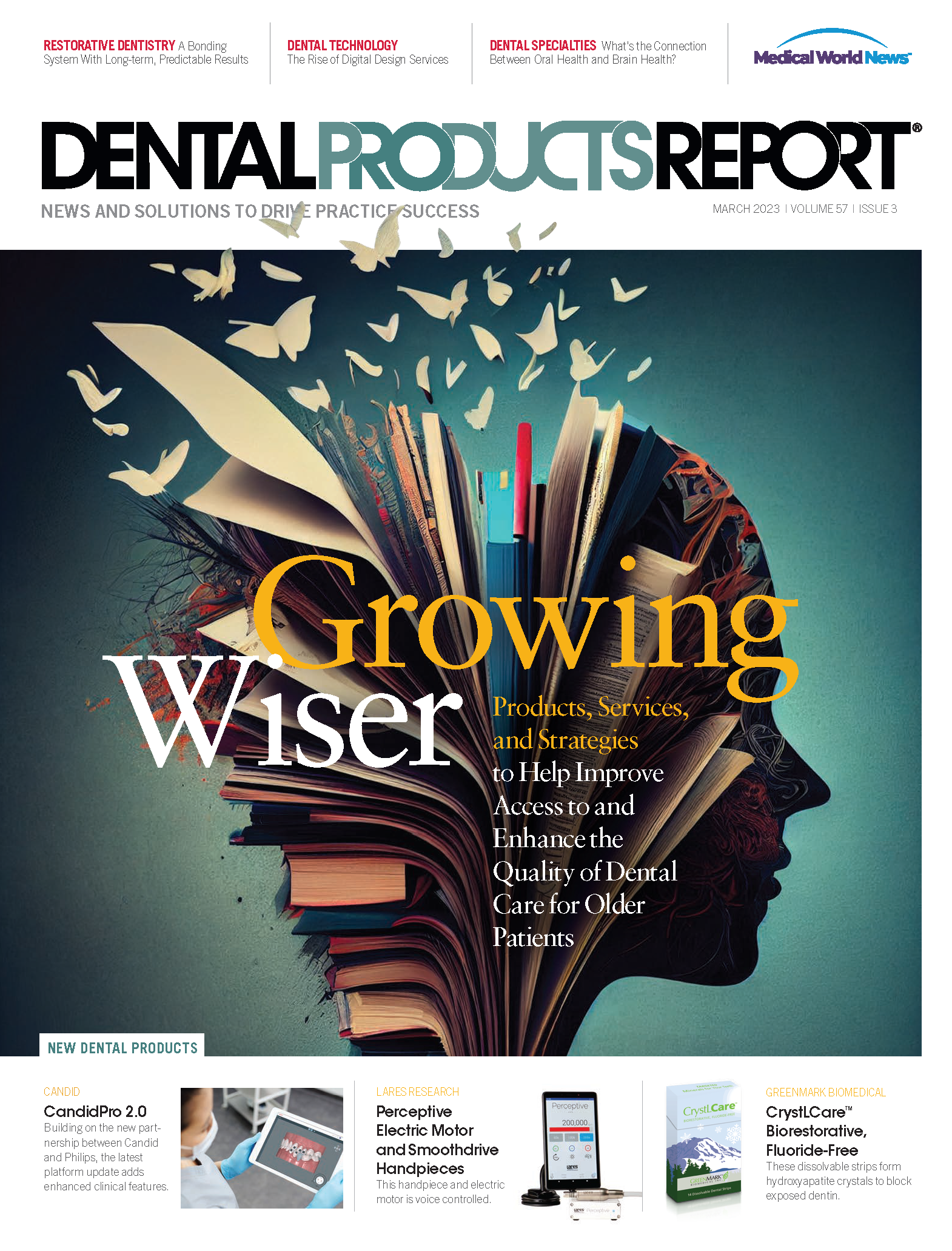Several factors may contribute to classifying a patient into a high caries risk category, including a deficiency of saliva, overconsumption of foods and beverages containing fermentable sugars, and lack of removal of bacteria-containing plaque. All these contributing factors affect the basic mechanism of caries in which bacteria in plaque metabolize fermentable sugars into acid, which can demineralize tooth structure despite the protective acid-neutralizing and remineralization potential of saliva. The dental clinician must address these factors when providing nonsurgical therapies to prevent future carious lesions and the progression of existing incipient lesions.
Infinix™ Universal Composite
Infinix Universal Composite is a light-cured, high viscosity universal dental restorative filling material with opt handling and strength. It offers superb performance across a variety of conditions, with the added benefit of Nobio QASi Antimicrobial technology to help reduce demineralization and secondary caries.
Nobio
844-463-4649 | infinix.com
In the case of a patient with a high caries risk, the clinician will often also need to address existing cavitated lesions with restorative treatment. In these cases, the restorative material may be selected to reduce the incidence of recurrent caries. Recurrent caries follows the same basic mechanism in which bacteria-containing plaque produce acid, which demineralizes the tooth structure surrounding a dental restoration. Most therapies used for preventive and restorative treatment have focused on increasing mineralization of tooth structure. However, there are also therapies that address the acid-producing bacteria that create demineralization.
Perhaps the most obvious way to address bacteria in plaque is to mechanically remove the plaque through home hygiene. The use of electric toothbrushes has been shown to reduce the incidence of plaque by 21% over the use of a manual toothbrush.1 Specifically, rotating-oscillating electric toothbrushes are more effective at plaque removal than other types of electric brushes.2
Interdental removal of plaque is also critical for preventing interproximal caries. Although the use of dental floss is likely the most commonly prescribed method of interdental cleaning, there is low-level evidence that interdental brushes may be more effective at removing plaque.3 There is not sufficient evidence to determine whether floss is more effective at interdental plaque removal than oral irrigation (ie, Waterpik).3
The use of chemical antibacterial agents to reduce caries, specifically a 0.12% chlorhexidine gluconate mouth rinse, has been controversial, as some studies have suggested that it is ineffective.4 However, a protocol suggested by Featherstone et al suggests that the inclusion of a 0.12% chlorhexidine gluconate mouth rinse once a day for 1 week per month in an oral hygiene regimen reduced cariogenic bacterial levels and the incidence of caries.5
A new approach for addressing recurrent caries is the use of antibacterial restorative materials incorporating quaternary ammonium compounds (QACs). QACs are positively charged molecules that are attracted to the negatively charged cell walls of bacteria. A long chain of the QAC can bind to and penetrate the bacterial cell wall and cause leakage of its cytoplasmic contents. Therefore, the mechanism of action of QAC-containing materials is a “contact kill.” QAC molecules have been incorporated into silica filler particles, known as QA silica (QASi) particles. Currently, the only commercially available resin composite containing these QASi particles is Infinix (Nobio Ltd).
One advantage of a bacteria-repelling composite is that it may prevent adherence of plaque on the surface of a restoration. Cariogenic bacteria can degrade the surface of a composite and increase its roughness, which leads to increased accumulation of additional plaque.6 The accumulation of bacteria in plaque may facilitate recurrent caries around the restoration. A direct contact laboratory study of the Infinix composite was performed, in which an inoculum of either Enterococcus faecalis (a cariogenic bacteria) or whole saliva was placed in contact with the composite in a well. After 20 hours of incubation, no growth of any microorganisms occurred on the composite.7 Additionally, Infinix composite was placed on the buccal surface of teeth in 3 volunteers. After 6 months, the Infinix composite led to between 28% and 54% more dead bacteria on its surface than a control composite, as determined by live/dead staining.8
Another advantage of an antibacterial composite is the elimination of bacteria at a potential gap between the composite and the tooth. An in situ study was performed, in which the Infinix composite was placed next to a slab of enamel separated by a 38-µ gap and inserted into a removable partial denture (RPD). A similar assembly was mounted into the contralateral side of the RPD with a control composite. The RPDs were given to 17 participants who wore them for 4 weeks. The composite/enamel assemblies were then removed from the RPDs and cross-sectioned. Microhardness of the enamel in the gap adjacent to the 2 composites was tested, and the enamel adjacent to the Infinix composite was significantly harder than the enamel adjacent to the control composite. This study demonstrates that the Infinix composite was better able to prevent demineralization of tooth structure in a potential microgap.
Any time a new resin composite is used in a patient, it is critical to ensure its mechanical properties are similar to existing restorative materials. Research testing was performed in our laboratory, which confirmed that the Infinix composite had similar or better mechanical properties (strength, wear resistance, and depth of cure) to several of the most common resin composites.8
Case Presentation
A 20-year-old patient had initially presented to the practice 4 years prior with carious lesions and recurrent caries around existing restorations. The patient was counseled regarding diet and oral hygiene habits and placed on 5000 ppm fluoride. Her carious lesions were restored with composite. For the next 2 years, the patient’s hygiene improved, and she did not develop new carious lesions. However, when the patient went to college, she stopped attending recall appointments for 2 years. When she returned to the practice, the patient’s parent expressed concern that the patient was not brushing her teeth in college. An intraoral exam revealed that her teeth had plaque collecting at the cervical areas of all her teeth. The patient was given a plaque disclosing tablet to make her aware of the areas at which she was collecting plaque. Her parent was also given plaque disclosing tablets to check her adherence with brushing. Additionally, a rotating-oscillating electric toothbrush was recommended.
The patient also had several cavitated lesions and recurrent caries that needed to be addressed, including a lesion on the facial surface of tooth #7 (Figure 1). At the time of the appointment, the patient still had plaque collecting at the cervical areas of her teeth (Figure 2). The patient and her parent were again shown her plaque in a patient mirror and reminded to improve oral hygiene. After anesthesia, caries was removed and the enamel was beveled (Figure 3). The enamel was etched, adhesive was placed, and the tooth was restored with composite. Because of the patient’s high caries risk and propensity for collecting plaque, the Infinix composite was utilized (Figure 4). The composite was polished, and the material blended with the existing tooth structure (Figure 5). The patient will continue to be monitored for the development of new lesions and recurrent caries, and oral hygiene instructions will be reinforced at each visit.
References
- Yaacob M, Worthington HV, Deacon SA, et al. Powered versus manual toothbrushing for oral health. Cochrane Database Syst Rev. 2014;2014(6):CD002281. doi:10.1002/14651858.CD002281.pub3
- Clark-Perry D, Levin L. Systematic review and meta-analysis of randomized controlled studies comparing oscillating-rotating and other powered toothbrushes. J Am Dent Assoc. 2020;151(4):265-275.e6. doi:10.1016/j.adaj.2019.12.012
- Worthington HV, MacDonald L, Poklepovic Pericic T, et al. Home use of interdental cleaning devices, in addition to toothbrushing, for preventing and controlling periodontal diseases and dental caries. Cochrane Database Syst Rev. 2019;4(4):CD012018. doi:10.1002/14651858.CD012018.pub2
- Autio-Gold J. The role of chlorhexidine in caries prevention. Oper Dent. 2008;33(6):710-716. doi:10.2341/08-3
- Featherstone JD, White JM, Hoover CI, et al. A randomized clinical trial of anticaries therapies targeted according to risk assessment (caries management by risk assessment). Caries Res. 2012;46(2):118-129. doi:10.1159/000337241
- Nedeljkovic I, De Munck J, Ungureanu AA, et al. Biofilm-induced changes to the composite surface. J Dent. 2017;63:36-43. doi:10.1016/j.jdent.2017.05.015
- Dekel-Steinkeller M, Weiss EI, Samovici TL, Abramovitz I. Antibacterial performance of composite containing quaternary ammonium silica (QASi) filler - a preliminary study. J Dent. 2022;123:104209. doi:10.1016/j.jdent.2022.104209
- Bora P, Lawson NC. Flexural strength, wear, and depth of cure of different composite resins. AADR abstract 2023 (accepted).

